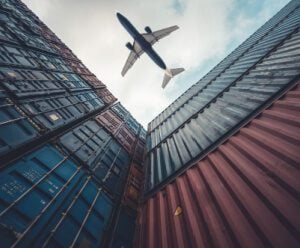
Air cargo’s seasonal surprise

Global air cargo markets continue to surprise on the upside with e-commerce demand on routes out of Asia driving both rates and demand.
The April edition of DHL’s Airfreight State of the Industry report noted that global air cargo demand climbed 6 percent in April compared to a year earlier, with demand for fashion and consumer products fuelling an e-commerce boom in Asia-Pacific trade.
“The surge in e-commerce has driven air cargo volumes up in the region beyond expectations. With global GDP growth now projected at 2.6 percent, slightly above its market prediction of 2.4 percent, we are seeing early signs of Asia-Pacific trade routes rebounding,” said Niki Frank, CEO, DHL Global Forwarding Asia Pacific.
And the economic mood music continues to sweeten, with inflation normalizing in many locations, and the JP Morgan Global Manufacturing PMI recently hitting its highest level since July 2022.
The DHL report further concluded that Asia Pacific is projected to increase widebody belly capacity in anticipation of the summer 2024 traffic season, with schedules suggesting that widebody belly capacity will likely exceed summer 2023 levels by double digits
Amid the e-commerce bloom season
Chinese e-retailers such as Temu and Shein have been widely credited for much of the upturn in the sector this year. In the final week of April, this additional demand helped push air spot rates from China to the United States (U.S.) up by 14 percent year-on-year. By comparison, the average global was 8 percent lower compared to a year earlier.
Having only launched in September 2022, Temu now has 51 million U.S. customers. Shein’s fashion and lifestyle app has achieved almost 14 million downloads, making the two marketplaces serious rivals to Amazon.
These emerging, aggressive buyers of air charter and bellyhold space are also using a different logistics strategy than Amazon and other e-commerce players sourcing in China. Instead of shipping inventory to major developed markets and distributing from domestic warehouses, they are relying on air services and flying products directly to consumers from factories in China. This enables faster delivery times without impinging on their ability to offer competitive prices.
A U.S. congressional report from June last year estimated that Shein and Temu were responsible for almost 600,000 packages arriving in the U.S. per day.
Apart from consumer goods, seasonal demand for flower exports amid the spring bloom has also provided an April boost for the air freight industry. Both Africa and the Central & South America (CSA) regions saw major weekly gains during the month. WorldACD noted that 84 percent of the tonnage growth ex-CSA was attributed to higher flower exports to North America, ahead of Mother’s Day in the U.S. and Canada on 12 May.
Frank concluded that air cargo demand may ease later on during the slower summer season, but early indicators suggest consistent growth, which will likely fuel a potential recovery throughout the year.
“Meanwhile, the exceptional surge in e-commerce, ocean shipping disruptions, and supply chain diversification will continue to drive air cargo demand on selected trade lanes. So we are cautiously optimistic for a stabilization and potential slight increase in air cargo demand compared to the latter half of 2023,” said Frank.
Tailgating e-retailers
While positive growth is welcome news for the air cargo market, the surge in demand is broaching capacity fears for the end-of-year holiday season.
“B2C e-commerce volumes continue to be the big driver of demand and worries about available capacity out of China, especially late in the year during air cargo’s peak season,” commented Judah Levine, Head of Research at Freightos.
Some carriers are taking steps to add capacity in response, including the newly announced transpacific service of Compagnie Maritime D’Affretement Compagnie Générale Maritime, which will launch in June. However, capacity is still expected to get even tighter in Q4.
Meanwhile, Chinese airlines are also increasing bellyhold capacity for U.S. flights. Stakeholders are contracting space now to avoid shortages later in the year, should e-retailer demand create a capacity crunch.
"The current surge may be attributed to the peak traffic season, but prioritizing the balance between demand and capacity remains paramount for ensuring sustained growth in air cargo throughout the year. Shippers must exercise foresight and secure capacity to pre-empt potential shortages later on,” said Frank.
E-commerce soars above the Red Sea
In less chipper news, the quasi blockade of the Suez Canal to shipping is also firing air freight demand which has now grown by double digits for four consecutive months.
Transit times to the U.S. East Coast and European destinations have increased by at least a week and by around two weeks to eastern Mediterranean destinations, while schedule reliability has tumbled.
“For apparel companies in India, Bangladesh, and Sri Lanka, this means shifting exports to the skies or missing the spring season,” Niall van de Wouw, chief air freight officer at Xeneta, said on a recent episode of The Loadstar podcast.
Sea-air options via Colombo, Sri Lanka, and Dubai, UAE, have also proven attractive for many shippers. As a result, spot rates have surged on lanes from South Asia and the Middle East to Europe.
However, operators reliant on Dubai have suffered their own difficulties in April. Not only did shipping in the Arabian Gulf come under increased threat after the seizure of the MSC Aries by Iran, but Dubai also suffered two years’ worth of rainfall in just 24 hours. This led to heavy flooding at Dubai International Airport (DXB), resulting in hundreds of cancelled flights, and the airport was temporarily closed.
Hong Kong = Number 1
Meanwhile, as Asia Pacific trade readies itself for economic recovery, airports in the region are preparing themselves to take on greater volumes.
Hong Kong might be losing container shipping port calls, but its air freight hub remains a formidable player in global trade. Last year, Hong Kong International Airport (HKIA) retained its position as the world’s busiest cargo airport after recording a 3.3 percent increase in volumes to take total throughput to 4.3 million tons.
Memphis cinched the second spot followed by Shanghai, Anchorage, and Incheon.
According to preliminary figures from Airports Council International (ACI), 2023 was the 13th time since 2010 that HKIA has taken the top spot. However, volumes remained down on 2019 levels when HKIA handled 4.8 million tons of freight.
To cope with growing volumes, HKIA has also been investing in the high-value and fast-growing e-commerce sector. Last year, the airport saw the completion of both the Cainiao Smart Gateway, developed by Alibaba Group’s logistics arm, and the expansion of DHL’s Central Asia Hub, which increased its capacity by 50 percent.
“Air cargo is a key driver of the growth of Hong Kong’s logistics industry and overall economic development,” said Jack So, chairman of Airport Authority Hong Kong (AAHK). “AAHK shall continue to work tirelessly with our air cargo community to further strengthen HKIA’s competitiveness as a global cargo hub.”
ALSO WORTH READING












 English
English